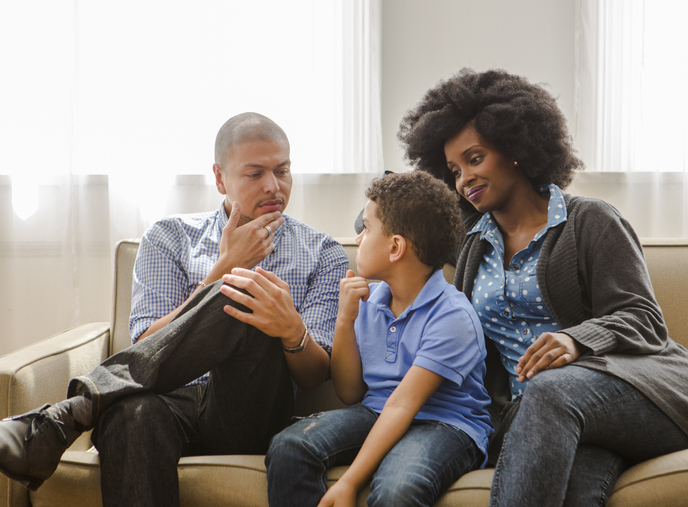 Do you feel like your child with ADHD has turned into a tech-obsessed stranger? If so, you are not alone. Many parents and caregivers are distraught and overwhelmed by the role that technology now plays in the lives of their children and teens. While you may sometimes want to throw the iPad, Chromebook, smartphone, etc. out of the window, I recommend that you take a deep breath and create a plan for a balanced media diet instead. The relationship between ADHD and technology can be positive, and a healthy balance will benefit your child and your family.
Do you feel like your child with ADHD has turned into a tech-obsessed stranger? If so, you are not alone. Many parents and caregivers are distraught and overwhelmed by the role that technology now plays in the lives of their children and teens. While you may sometimes want to throw the iPad, Chromebook, smartphone, etc. out of the window, I recommend that you take a deep breath and create a plan for a balanced media diet instead. The relationship between ADHD and technology can be positive, and a healthy balance will benefit your child and your family.
The acronym SCREENS can assist you with managing ADHD and technology:

Start with reasonable goals.
Collaborate on your technology plan.
Redirect to agreed-upon alternatives.
Expect pushback and decide in advance what to do.
Employ Easy on/Easy off technique.
Notice cooperation and nurture consistency.
Screens stay out of bedrooms at night.
Putting SCREENS to practice for ADHD and technology at home:
START with reasonable goals about media use right now.
During COVID, kids are on their technology more, plain and simple. But this doesn’t mean that they should have free rein over screen use in your family. What do you think is a reasonable daily amount of screen time? What do they think? If you are unsure, talk with your pediatrician or primary care provider for their advice on balancing ADHD and technology. The goal is balancing the high dopamine activities of online stimulation with lower dopamine periods to rebalance brain chemistry and settle down.
COLLABORATE on a plan about when and where screen time occurs.
 All screen time is not equal: there’s a difference between TikTok, texting, Snapchat, gaming, surfing the net and watching television. Talk about these differences and how to equalize them. Then, find neutral ground between what your kids want and what you think is best. The bar may be lower now due to COVID, and that’s okay. Let them know it’s an evolving situation where things can change.
All screen time is not equal: there’s a difference between TikTok, texting, Snapchat, gaming, surfing the net and watching television. Talk about these differences and how to equalize them. Then, find neutral ground between what your kids want and what you think is best. The bar may be lower now due to COVID, and that’s okay. Let them know it’s an evolving situation where things can change.
REDIRECT and be very clear about what qualifies as inappropriate use of technology.
Sexting, online bullying, visiting unsuitable sites, sneaking devices and being online at 2 a.m indicate a lack of respect about screen privileges. Discuss these differences and set up logical consequences for these type of behaviors. In addition, set up ways for your child to earn back your trust.
EXPECT PUSHBACK and you will not be surprised when it arises once again.
 Your child or teen will not thank you for creating screen time as an earned privilege. In fact, they will most likely become angry and tell you that being online is their right. I don’t agree. Our children are entitled to food, clothing, shelter, love, healthcare, education and a secure environment. Screen time is not on this list. Instead, I see it as a ‘want-to” that follows the ‘have-to’s’ of life. Have a plan in place for this so you are prepared. Also, be sure to monitor your own screen use. Kids with ADHD can smell hypocrisy a mile away. They will howl if adults stay on their phone at dinner but the kids’ phones are relinquished for a quiet meal.
Your child or teen will not thank you for creating screen time as an earned privilege. In fact, they will most likely become angry and tell you that being online is their right. I don’t agree. Our children are entitled to food, clothing, shelter, love, healthcare, education and a secure environment. Screen time is not on this list. Instead, I see it as a ‘want-to” that follows the ‘have-to’s’ of life. Have a plan in place for this so you are prepared. Also, be sure to monitor your own screen use. Kids with ADHD can smell hypocrisy a mile away. They will howl if adults stay on their phone at dinner but the kids’ phones are relinquished for a quiet meal.
EMPLOY EASY ON/EASY OFF TECHNIQUE and think about the role that you want technology to play in your family.
Decide how much screen time (not for school) you want your child or teen to have daily. Have a conversation about how much they desire. Then, decide on a baseline amount and a bonus amount of time. Perhaps the baseline is one hour after homework is completed and another two hours for earned time. How kids EASE OFF baseline once it is completed determines if they earn some of the bonus time. You can also attach bonus time to completion of chores, lack of yelling or cursing, readiness for school, going to bed on time, etc. Any desired behavior should be linked to earned screen time. Write down your plan and post it in the kitchen so it can be referred to easily.
NOTICE AND VALIDATE COOPERATION; managing ADHD and technology is not easy.
 Notice and validate any cooperation your child offers and expect to adjust the plan along the way. Balancing ADHD and technology as a child or teen is really difficult! Pick a time for a short weekly family meeting to discuss the earned privileges plan (maybe give it a snappy name) and how it’s going. Expect to make adjustments, but do not do this in the middle of an escalation. Your child will exert many tactics to get you to back down. Stay steady!! Let them know that all changes can be discussed in the weekly meeting and that negotiation does not mean they will get what they want. A good compromise occurs when everybody is a bit unhappy with the agreement.
Notice and validate any cooperation your child offers and expect to adjust the plan along the way. Balancing ADHD and technology as a child or teen is really difficult! Pick a time for a short weekly family meeting to discuss the earned privileges plan (maybe give it a snappy name) and how it’s going. Expect to make adjustments, but do not do this in the middle of an escalation. Your child will exert many tactics to get you to back down. Stay steady!! Let them know that all changes can be discussed in the weekly meeting and that negotiation does not mean they will get what they want. A good compromise occurs when everybody is a bit unhappy with the agreement.
SCREENS STAY OUT OF BEDROOMS AT NIGHT to avoid sneaking and using technology at inappropriate times.
Our brains need a break from looking at a screen to integrate, regroup and rest. Middle-of-the night texting, gaming or watching YouTube videos disrupts kids’ sleep and makes for tired, cranky children. Set up a screen-free family time during the day (meals, chores, games, baking, sports, etc.). This will give kids a chance to connect with others and practice real time social skills. It will also foster closer relationships with you through conversation and activity.
Good luck, and remember that any change takes time, practice and patience to take hold!
Read more blog posts:
- ADHD and Screen Sanity: Why a digital break is good for everybody right now
- Regulate Summer Screen Time for Your Child with ADHD and Yourself
- ADHD, Defiance and COVID: What can you do instead of yelling?
Learn more:
- From Screen Time to Safe Socializing: The Summer 2020 Guide for ADHD Families (Additude Magazine article by Dr. Saline)
https://drsharonsaline.com/product/managing-technology-families-video/ https://drsharonsaline.com/product/online-learning-tips-for-parents-bundle/ https://drsharonsaline.com/product/smartphones/ Read more about ADHD












 me repeatedly that they feel bad about themselves after these outbursts and many parents also regret what they’ve said or done. But, in moments of high emotion, people naturally stop listening and quickly move into fight-flight-or-freeze mode. In this state, whether or not your struggle with ADHD and defiance, you’re not listening. Instead, you’re reacting, and rationality has flown out of the window.
me repeatedly that they feel bad about themselves after these outbursts and many parents also regret what they’ve said or done. But, in moments of high emotion, people naturally stop listening and quickly move into fight-flight-or-freeze mode. In this state, whether or not your struggle with ADHD and defiance, you’re not listening. Instead, you’re reacting, and rationality has flown out of the window. 




 Resilience is the ability to rebound from difficulties. There’s a myth that resilience is about your character. It actually has as much, if not more, to do with your socioeconomic status, religious and ethnic background. Numerous obstacles such as financial stress, unemployment, bigotry and systemic racism demand resources beyond ‘resilience.’ Similarly, children and adults living with ADHD, persistent mental health issues or physical or learning disabilities struggle daily with challenges that demand effective coping strategies. When we offer platitudes about “digging deep” and “finding your resilience,” we may inadvertently dismiss the validity of these struggles.
Resilience is the ability to rebound from difficulties. There’s a myth that resilience is about your character. It actually has as much, if not more, to do with your socioeconomic status, religious and ethnic background. Numerous obstacles such as financial stress, unemployment, bigotry and systemic racism demand resources beyond ‘resilience.’ Similarly, children and adults living with ADHD, persistent mental health issues or physical or learning disabilities struggle daily with challenges that demand effective coping strategies. When we offer platitudes about “digging deep” and “finding your resilience,” we may inadvertently dismiss the validity of these struggles. 



 Do you ever notice how your heart races in similar ways when you’re anxious and when you’re excited? The energy courses through your body and brain, and you feel a type of exhilaration. Of course, it’s more negative for anxiety and more positive for excitement. In both cases, however, our adrenaline is activated because anxiety and excitement really are like two sides of the same coin. Managing both types of these intense, overwhelming reactions is especially taxing for kids with ADHD due to their challenges with impulse control and emotional regulation. How can you help transform anxiety in kids with ADHD into eager anticipation?
Do you ever notice how your heart races in similar ways when you’re anxious and when you’re excited? The energy courses through your body and brain, and you feel a type of exhilaration. Of course, it’s more negative for anxiety and more positive for excitement. In both cases, however, our adrenaline is activated because anxiety and excitement really are like two sides of the same coin. Managing both types of these intense, overwhelming reactions is especially taxing for kids with ADHD due to their challenges with impulse control and emotional regulation. How can you help transform anxiety in kids with ADHD into eager anticipation?


 Let’s face it, New Year’s resolutions rarely work. We all set well-intentioned goals about what we can do differently that rarely come to fruition. This year, I’d like to encourage you and your family to try something different. Instead of choosing something that isn’t going well, what would happen if you nurture one thing that makes you happy, that you are already making progress on? My guess is that you and your child or teen with ADHD would feel more competent and confident.
Let’s face it, New Year’s resolutions rarely work. We all set well-intentioned goals about what we can do differently that rarely come to fruition. This year, I’d like to encourage you and your family to try something different. Instead of choosing something that isn’t going well, what would happen if you nurture one thing that makes you happy, that you are already making progress on? My guess is that you and your child or teen with ADHD would feel more competent and confident.  There’s been so much disappointment across the board. For many children and teens with ADHD who already experience more negative self-talk than Neurotypical peers, pandemic challenges have intensified patterns of self-criticism. Working with them to alter these patterns by focusing on Celebration (the 5th of my 5C’s) is the best New Year’s resolution you can make.
There’s been so much disappointment across the board. For many children and teens with ADHD who already experience more negative self-talk than Neurotypical peers, pandemic challenges have intensified patterns of self-criticism. Working with them to alter these patterns by focusing on Celebration (the 5th of my 5C’s) is the best New Year’s resolution you can make. 
 Instead of making New Year’s resolutions about a host of ongoing problems that just generate shame and failure, let’s cultivate the plants that are already in the garden right now.
Instead of making New Year’s resolutions about a host of ongoing problems that just generate shame and failure, let’s cultivate the plants that are already in the garden right now.

 What a year this has been! 2020 has redefined what it means to bounce back. Just when you think you’ve set up a routine that works and life seems to be chugging along, something comes and upsets the whole apple cart again. Pivoting to these new challenges, everybody has repeatedly been forced to regroup, think quickly and adapt.
What a year this has been! 2020 has redefined what it means to bounce back. Just when you think you’ve set up a routine that works and life seems to be chugging along, something comes and upsets the whole apple cart again. Pivoting to these new challenges, everybody has repeatedly been forced to regroup, think quickly and adapt.  As parents, you have risen to the enormous challenges of this pandemic. You’ve created effective routines to manage remote learning, homework and chores, often in combination with your own work, and tweaked them as needed. You’ve fought so that the educational needs of your Neurodiverse sons and daughters are met in this new academic environment. You arranged music lessons, safe participation in sports and socially distant playdates. You’ve lost your tempers, wished you had some time to yourself and did the right thing for your kids despite the personal cost. You grieved the loss of loved ones and nursed the sick back to health. You rose to meet this awful pandemic and showed up even when you felt sapped of strength.
As parents, you have risen to the enormous challenges of this pandemic. You’ve created effective routines to manage remote learning, homework and chores, often in combination with your own work, and tweaked them as needed. You’ve fought so that the educational needs of your Neurodiverse sons and daughters are met in this new academic environment. You arranged music lessons, safe participation in sports and socially distant playdates. You’ve lost your tempers, wished you had some time to yourself and did the right thing for your kids despite the personal cost. You grieved the loss of loved ones and nursed the sick back to health. You rose to meet this awful pandemic and showed up even when you felt sapped of strength. 
 During this holiday season, I hope that you and your family acknowledge all of the strides you have made by creating a Wall of Wonder. Get some Post-It’s, open some space on a wall and encourage people to write down (or draw) and post any of the following:
During this holiday season, I hope that you and your family acknowledge all of the strides you have made by creating a Wall of Wonder. Get some Post-It’s, open some space on a wall and encourage people to write down (or draw) and post any of the following:





